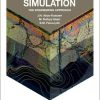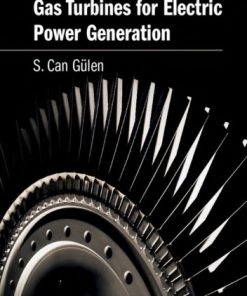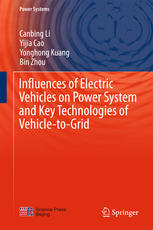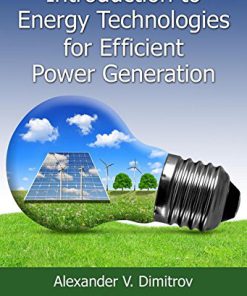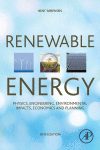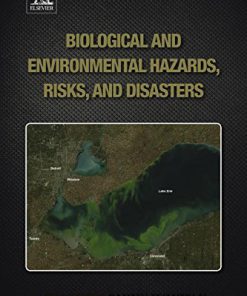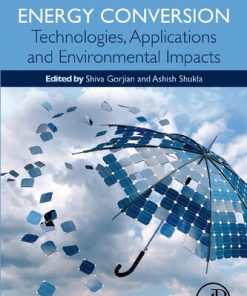Handbook of Distributed Generation Electric Power Technologies Economics and Environmental Impacts 1st Edition by Ramesh Bansal 3319513430 9783319513430
$50.00 Original price was: $50.00.$25.00Current price is: $25.00.
Handbook of Distributed Generation Electric Power Technologies Economics and Environmental Impacts 1st Edition by Ramesh Bansal – Ebook PDF Instant Download/DeliveryISBN: 3319513430, 9783319513430
Full download Handbook of Distributed Generation Electric Power Technologies Economics and Environmental Impacts 1st Edition after payment.
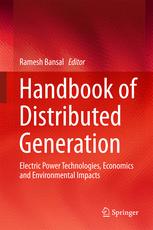
Product details:
ISBN-10 : 3319513430
ISBN-13 : 9783319513430
Author: Ramesh Bansal
This book features extensive coverage of all Distributed Energy Generation technologies, highlighting the technical, environmental and economic aspects of distributed resource integration, such as line loss reduction, protection, control, storage, power electronics, reliability improvement, and voltage profile optimization. It explains how electric power system planners, developers, operators, designers, regulators and policy makers can derive many benefits with increased penetration of distributed generation units into smart distribution networks. It further demonstrates how to best realize these benefits via skillful integration of distributed energy sources, based upon an understanding of the characteristics of loads and network configuration.
Handbook of Distributed Generation Electric Power Technologies Economics and Environmental Impacts 1st table of contents:
1 Distributed Renewable Energy Technologies
1.1 Introduction
1.2 Solar Photovoltaic Technology
1.2.1 Solar Cell Working Principle
1.2.2 Solar Cell Electrical Characteristics
1.2.3 Photovoltaic Systems for Distributed Generation
1.3 Wind Technology
1.3.1 Wind Energy Conversion
1.3.2 Wind Energy Technologies
1.3.3 Fixed-Speed Wind Turbine
1.3.4 Variable-Speed Wind Turbine
1.3.5 Fully Rated Converter (FRC) Wind Turbine
1.3.6 Doubly Fed Induction Generator (DFIG) Wind Turbine
1.3.7 Model for SCIG Power Flow Calculation
1.3.8 Maximum Power Point Tracking for Variable-Speed Wind Turbines
1.3.9 Advantages of Wind Power
1.3.10 Disadvantages of Wind Power
1.4 Biomass/Biogas Technology
1.4.1 Biomass Estimation
1.4.2 Biomass Combustion
1.4.3 Hydrogen Production from Biomass
1.4.4 Biogas Technology
1.4.5 Biogas Composition
1.4.6 Operating Parameters
1.4.7 Anaerobic Digestion Overview
1.4.8 Advantages and Disadvantages of Biogas Technology
1.4.9 Biogas Technology Applications
1.4.10 Biogas for Mobility
1.4.11 Generation of Electricity and Heat (CHP)
1.4.12 Biogas for the Natural Gas Grid
1.5 Small Hydroelectric Power Plants for Distributed Generation
1.5.1 Overview
1.5.2 Components of a Small Hydropower System
1.5.3 System Parameters
1.6 Fuel Cells
1.6.1 Basic Structure
1.6.2 Types of Fuel Cells
1.6.3 Applications
1.7 Geothermal Technology
1.7.1 Current Status of the Geothermal Potential in the World
1.7.2 The Technical, Economic and Environmental Benefits of Geothermal Energy
1.7.3 Comparison of Geothermal Energy with Other Renewable Energy Resources
1.7.4 Geothermal Technology Applications
1.7.5 Direct-Use Applications
1.7.6 Heat Pumps
1.7.7 Geothermal Electricity Production
1.7.8 Direct Dry Steam
1.7.9 Flash Steam Power Plants
1.7.10 Binary Cycle Power Plants
1.7.11 Levels of Emission from Different Types of Geothermal Energy Power Plants
1.7.12 Challenges of Geothermal Technologies
1.8 Ocean Thermal Energy Conversion
1.8.1 Technology Types
1.8.2 Advantages and Disadvantages of OTEC
1.9 Conclusion
References
2 Non-renewable Distributed Generation Technologies: A Review
2.1 Introduction
2.1.1 Technology Description of the Reciprocating Engines
2.1.1.1 Comparative Analysis of the Reciprocating Engines
2.1.1.2 Applications of the Reciprocating Engines
Standby Power
Peak Shaving
Grid Support
Combined Heat and Power
2.1.2 Classes of Reciprocating Engines
2.1.2.1 Methods of Igniting the Fuels
2.1.2.2 Operation of a Diesel Engine
2.1.2.3 Operation of a Spark-Ignition Engine
2.1.2.4 Operating Cycle or Number of Strokes
2.1.2.5 Speed
High Speed
Medium Speed
Low Speed
Ratings
Standby Generators
Prime Generators
Continues Generators
2.1.3 Performance of Reciprocating Engines
2.1.3.1 Heat Rate
2.1.3.2 Efficiency
2.1.3.3 Capacity Factor
2.1.3.4 Load Factor
2.1.4 Emissions
2.1.4.1 Sulphur Oxides Emissions
2.1.4.2 NOx Emissions
2.1.4.3 CO2 Emissions
2.1.4.4 CO Emissions
2.1.4.5 Emission Control
2.1.5 Plant Availability
2.1.6 Fuels
2.1.6.1 Liquid Fuels
2.1.6.2 Natural Gas
2.1.6.3 Alternative Gas Fuels
2.1.7 Fuel Cost
2.1.8 Cost of Electricity Production
2.1.9 Maintenance
2.2 Microturbines in Distributed Generation System
2.2.1 Brief Descriptions
2.2.2 Technology Description
2.2.2.1 Working Principle
2.2.2.2 Classification of Microturbines
Single-Shaft Microturbine
Two-Shaft Microturbines
2.2.2.3 Comparison Between Single and Two-Shaft Microturbines
2.2.2.4 Combined Heat and Power
2.2.2.5 Fuels
2.2.2.6 Thermal Modelling of a Microturbine
Mass Balance
Energy Balance
2.2.3 Microtubines in Hybrid Energy Systems
2.2.3.1 Hybridization of Fuel Cell with Microturbine
2.2.3.2 Hybridization of Microturbine with Multiple Energy Sources
2.2.3.3 Hybridization of Microturbine with Residential Rooftop Solar PV System
2.2.4 Economic Analysis of a Microturbine
2.2.4.1 Life Cycle of a Microturbine
2.2.4.2 Levelized Cost of a Microturbine
2.2.5 Systems Optimization
2.2.6 Comparison with Reciprocating Engines
2.2.6.1 Advantages
2.2.6.2 Disadvantages
2.3 Conclusion
References
Wind Power Systems
3 Large-Scale Wind Generation Development in the Mexican Power Grid: Impact Studies
3.1 Overview
3.2 System Description and Scenario Definitions
3.2.1 The SE Transmission System
3.2.2 Operational Challenges Presented by Wind Generation
3.3 Short-Term Wind Generation Forecasting
3.3.1 State-Space Modeling Framework
3.3.2 Smoothing Algorithms
3.3.3 Stochastic Trend Extraction
3.3.4 Short-Term Prediction of Wind Output
3.4 Dynamic Impact of Wind Energy
3.4.1 Effect of Wind Generation on Oscillatory Stability
3.4.2 Large System Performance
3.4.3 Advanced Monitoring of System Behavior
3.5 System Frequency Control
3.5.1 Frequency Control in the Southeastern System
3.5.2 Wind Integration Cases Studies
3.5.3 Performance Under High Levels of Wind Penetration
3.5.4 Impact of Wind Generation on Frequency Regulation
3.5.5 Inertial Support and Active Power Control
3.6 Impact on Torsional Dynamics
References
4 Load Flow Analysis with Wind Farms
4.1 Introduction
4.2 Wind Energy Conversion Systems (WECS)
4.3 Load Flow Analysis
4.4 Modeling of Wind Farms
4.4.1 Model-1: PQ Model of Asynchronous WT
4.4.1.1 Conventional PQ Model
4.4.1.2 Modified PQ Model
4.4.2 Model-2: RX Model
4.4.2.1 Conventional Model
4.4.2.2 Modified Model: RX2
4.4.3 Model-3: Three-Node Model
4.4.4 Model-3: Probabilistic Model
4.5 Results Discussion
4.5.1 Study-1
4.5.2 Study-2
4.5.3 Study-3
4.5.4 LFA Using Model-3
4.6 Conclusions
References
5 Sensor-Less Estimation of Rotor Position in a Doubly Fed Induction Machine
5.1 Grid-Connected Doubly Fed Induction Machine
5.2 Basics of Decoupled Control
5.2.1 Control of Rotor-Side Converter (RSC)
5.2.2 Control of Front-End Converter (FEC)
5.3 Significance of Rotor Position and Speed
5.4 Brief Review of Sensor-Less Estimation Techniques
5.5 Sensor-Less Estimation of Rotor Position
5.5.1 Open Loop Techniques
5.5.1.1 Computing Rotor Position of a Grid-Connected DFIM
5.5.1.2 Case of Constant Stator Flux
5.5.1.3 Case of Fluctuating Stator Flux
5.5.1.4 Results and Discussion
Verification of RPCA
5.5.2 Closed Loop Techniques
5.5.2.1 Closed Loop Rotor Position Computation
Rotor-Side Phase-Locked Loop (R-PLL) for the Computation of Rotor Position of a DFIM
5.5.3 Results and Discussion
5.6 Conclusions
Appendix
References
6 Wind Turbine Standards and Certification: Indian Perspective
6.1 Introduction
6.2 History and Contemporary Scenario of WT Standards and Certification
6.3 An Overview of Standards IEC 61400 for WT
6.3.1 IEC 61400-1 Design Requirements
6.3.1.1 Principal Elements
6.3.1.2 External Conditions
6.3.1.3 Structural Design
6.3.1.4 Control and Protection System
6.3.1.5 Mechanical Systems
6.3.1.6 Electrical System
6.3.1.7 Assessment of a WT for Site-Specific Conditions
6.3.1.8 Assembly, Installation, and Erection
6.3.1.9 Commissioning, Operation, and Maintenance
6.4 Description of Type Approval Provisional Scheme (TAPS-2000)
6.4.1 Provisional Type Certification (PTC)
6.4.1.1 PTC: Category I
Partial Design Evaluation/Review of Type Certificate
Manufacturing System Evaluation
Review of Foundation Design Requirements
Foundation Design Evaluation
Final Evaluation Report
Provisional Type Certificate
6.4.1.2 PTC: Category II
Provisional Type Test
Type Characteristic Measurement
6.4.1.3 Provisional Type Certification: Category III
6.4.1.4 Relevant External Environmental Conditions in India for TAPS
6.5 Conclusions
References
7 Egyptian Grid Code of Wind Farms and Power Quality
7.1 Introduction
7.2 Conditions of Connection and Disconnection of Wind Farms
7.2.1 Start-Up of Wind Farm Conditions
7.2.2 Reconnection of Disconnected Wind Farm Conditions
7.2.3 Disconnection Conditions
7.3 Active Power Regulations Modes for the Wind Farms
7.4 Power Quality
7.4.1 Harmonics
7.4.2 Voltage Flickers
7.4.3 Voltage Imbalance
7.4.4 Voltage Fluctuations
7.5 Power Factor and Reactive Power Control
7.6 Voltage Disturbances
7.6.1 Single and Multi Low-Voltage Ride-Through Capabilities
7.6.2 Dynamic Regulations During Faults
7.6.3 Dynamic Regulations After Faults
7.7 Grid Protection
7.8 Summary
Acknowledgements
References
8 Integrating an Offshore Wind Farm to an Existing Utility Power Network via an HVDC Collection Grid
8.1 Introduction
8.1.1 Wind Farm with Output AC Power Collector
8.1.2 Wind Farm with Output DC Power Collector
8.1.3 Aim of Study and Contribution
8.2 Proposed Distributed Power System Description
8.3 AC Power Network
8.3.1 Active and Reactive Power Control Methods at Bus 4 of Fig. 8.1
8.3.2 AC Power Network Solution Using Load-Flow Analysis Method
8.4 DC Power Network Analysis
8.4.1 Protective Device
8.4.2 BSS and PV System
8.5 DC Collection Grid: Power Control Techniques
8.5.1 BSS Output Power Control Using Buck–Boost DC–DC Converter
8.5.2 PV Output Power Control Using Boost DC–DC Converter
8.5.3 Offshore Wind Farm Output Power Control Using Active Rectifiers
8.6 DC Power Collection Grid Analysis
8.6.1 Effect of Input Power Factor on Maximum Active Power Tracking
8.6.2 Equivalent Circuit Diagram of DC Power Collection Grid
8.6.3 Automatic Adapter Layout
8.7 DC Collection Grid: Voltage and Current Dynamics
8.7.1 Voltage/Current Output Characteristics of WECU
8.7.2 Voltage/Current Characteristics Across DC Collector
8.8 Conclusion
References
PV Systems
9 Steady-State Analysis of Unbalanced Distribution Networks with High Penetration of Photovoltaic Ge
9.1 Introduction
9.2 Need for Detailed Modelling of Unbalanced Distribution Networks
9.3 Phase-Domain Modelling
9.3.1 Voltage Regulators
9.3.2 Photovoltaic Generators and Power Electronic Converters
9.4 Sequential Time Simulations
9.4.1 Inadequacy of Extreme Value Analysis
9.4.2 Data Requirements and Time Resolution
9.5 Feeder Response Characteristics
9.5.1 Effect of Size, Type and Location of Photovoltaic Generators
9.5.2 Effect of Network-Specific Factors on Feeder Response Characteristics
9.6 Case Studies
9.6.1 Analysis of IEEE Standard Test Feeders
9.6.2 Analysis of an Actual Distribution Network
9.7 Feeder Voltage Profile with Photovoltaic Generation
9.7.1 Minimum and Maximum Node Voltages
9.7.2 Voltage Fluctuations and Voltage Flickers
9.8 Power and Energy Losses
9.8.1 Losses with Increasing Penetration of Photovoltaic Generation
9.8.2 Reverse Power Flow
9.9 Real and Reactive Power Demand and Power Factor
9.9.1 Real Power Demand at Substation Node
9.9.2 Reactive Power Flow and Reactive Power Demand
9.9.3 Power Factor at Substation Node
9.9.4 PV Inverter Power Factor and Its Control
9.10 Performance of Voltage Regulators and Shunt Capacitors
9.10.1 Tap Change Operations of Automatic Voltage Regulators
9.10.2 Switching of Shunt Capacitors in the Presence of PV Generators
9.10.3 Coordination of Voltage Regulators and Shunt Capacitors
9.11 Role of Energy Storage Systems with PVDGs
9.12 Conclusion
References
10 Distributed Solar-PV Generation: Impact on Voltage Control and Stability
10.1 Introduction
10.2 Modelling of Solar-PV Systems
10.2.1 Active and Reactive Power Characteristics
10.3 Voltage Regulation in Distribution Feeders
10.3.1 Voltage Regulation Standards
10.3.2 Methods to Improve Distribution Feeder Voltage Regulation
10.4 Impact of Solar-PV Generation on Feeder Voltage Regulation
10.4.1 Voltage Rise Issues with Solar-PV Generation
10.4.2 Voltage Regulation Methods with Distributed Solar-PV Generation
10.4.3 Case Study—Mitigation of Voltage Rise in Distribution Feeders with Solar-PV Generation
10.5 Voltage Stability with Solar-PV Generation
10.5.1 Voltage Stability Definition
10.5.2 Static Voltage Stability with Solar-PV Generation
10.5.3 Dynamic Voltage Stability with Solar-PV Generation
10.6 Discussion and Conclusions
References
11 Techno-economic Evaluation of Grid-connected Solar Photovoltaic Power Plant for Rural Banks
11.1 Introduction
11.2 Power Crisis
11.3 Solar Energy Availability
11.4 Load Pattern
11.5 System Sizing
11.5.1 Minimum SSEG
11.5.2 Maximum SSEG
11.5.3 Optimum SSEG
11.5.4 Economics
11.5.5 Energy Generation
11.6 Economics of the Project
11.7 Results and Discussions
11.8 Conclusions
References
12 Indirect Matrix Converter for Distributed Generation Application: An Experimental Study
12.1 Introduction
12.2 Topology of Wind Energy Conversion System Under Investigation
12.3 Novel Control Scheme
12.4 Development of Hardware Laboratory Prototype
12.5 Experimental Investigation
12.5.1 Response Under Isolated Mode
12.5.1.1 Response During Constant Resistive and Nonlinear Inductive Load
12.5.1.2 Response During Nonlinear Inductive Dc Load
12.5.1.3 Response During Varying Load Condition
12.5.2 Response Under Grid-Connected Mode
12.5.2.1 Under Steady-State Condition
12.5.2.2 Dynamic Response Under Change in Current Command
12.6 Conclusion
References
13 An Experimental Study on Zeta Buck–Boost Converter for Application in PV System
13.1 Introduction
13.2 Topology of Proposed Photovoltaic System
13.3 Novel Control Scheme
13.4 Development of Hardware Laboratory Prototype
13.5 Experimental Study Under Different Conditions
13.6 Conclusion
References
DG Modelling, Operation, Control, Protection
14 Modelling, Design, and Control of Smart DC Microgrid for Integration of Various Non-conventional
14.1 Introduction
14.2 Proposed Architecture of a Smart DC Microgrid
14.3 Modelling of DC Microgrid Components
14.3.1 Distributed Generators
14.3.1.1 Wind Turbine DG
14.3.1.2 Solar Photovoltaic System
14.3.1.3 Solid Oxide Fuel Cell DG
14.3.2 Battery Energy Storage System
14.3.3 DC and AC Loads
14.3.4 PWM-Based Voltage Source Converters
14.3.4.1 Three-Phase Voltage Source Converters
Three-Phase Voltage Source Rectifier
Three-Phase Voltage Source Inverter
Modelling of Three-Phase VSR Under Unbalanced Loads
Modelling of Three-Phase VSI Under Unbalanced Loads
Three-Phase Back-to-Back (AC-DC-AC) VSC
14.3.4.2 Single-Phase Voltage-Controlled Voltage Source Inverter
14.3.4.3 DC-DC Buck Converter
14.3.4.4 DC-DC Boost Converter
14.3.4.5 Bidirectional DC-DC Converter
14.4 Design of VSC Components
14.4.1 DC Link Capacitor for VSC
14.4.2 Phase Reactors for Three-Phase VSR
14.4.3 LC and LCL Filters for VSI
14.4.4 Components of DC-DC Buck Converter
14.4.5 Components of DC-DC Boost Converter
14.5 Proposed Control Strategy of Bidirectional Three-Phase VSC for WT DG Integration
14.6 Control Strategies of DC-DC Boost Converters
14.7 Simulation Results Under Islanded Mode
14.7.1 Case 1: Variable Power Generation and Constant Load Without BESS
14.7.2 Case 2: Variable Generation and Variable Load with BESS
14.8 Conclusions
References
15 Effects of DG Operating Power Factor on Its Location and Size by Using GA in Distribution Systems
15.1 Introduction
15.1.1 A Brief History of DG
15.1.2 Definition of DG
15.1.3 DG Technologies
15.1.4 Types of DG
15.1.5 Benefits and Drawbacks of DG
15.1.6 Applications of DG
15.1.7 Advances in DG
15.2 Mathematical Modeling of DG
15.2.1 DG Modeling
15.2.2 Distribution Power System Performance Indices
15.2.2.1 Real Power Loss Index (PL_Index)
15.2.2.2 Reactive Power Loss Index (QL_Index)
15.2.2.3 Voltage Deviation Index (VD_Index)
15.2.2.4 Real Power Penetration of DG (DG_P (P)_Index)
15.2.2.5 Reactive Power Penetration of DG (DG_Q(P)_Index)
15.2.2.6 System Power Factor
15.3 Proposed Methodology for Optimal Placement and Size of DG
15.3.1 Fundamentals of GA
15.3.2 Reason for GA Used for Optimization of Problem
15.3.3 GA Overview
15.3.3.1 Selection Operator
15.3.3.2 Crossover Operator
15.3.3.3 Mutation
15.3.4 Effects of Genetic Operators
15.4 Simulation Results and Discussions
15.4.1 IEEE 38-Bus Test System and Its Data
15.4.2 Real and Reactive Power Exponential Indices for DLMs [16, 72, 73]15.4.3 Analysis of DG Operating at 0.82 Leading Power Factor with DLMs
15.4.3.1 PL_Index
15.4.3.2 QL_Index
15.4.3.3 VD_Index
15.4.3.4 DG_P (P)_Index
15.4.3.5 DG_Q (P)_Index
15.4.3.6 System Power Factor
15.4.4 Analysis of DG Operating at 0.86 Leading Power Factor with Different Load Models
15.4.4.1 PL_Index
15.4.4.2 QL_Index
15.4.4.3 VD_Index
15.4.4.4 DG_P (P)_Index
15.4.4.5 DG_Q (P)_Index
15.4.4.6 SPF
15.4.5 Analysis of DG Operating at 0.92 Leading Power Factor with DLMs
15.4.5.1 PL_Index
15.4.5.2 QL_Index
15.4.5.3 VD_Index
15.4.5.4 DG_P (P)_Index
15.4.5.5 DG_Q (P)_Index
15.4.5.6 SPF
15.4.6 Analysis of DG Operating at 0.96 Leading Power Factor with DLMs
15.4.6.1 PL_Index
15.4.6.2 QL_Index
15.4.6.3 VD_Index
15.4.6.4 DG_P (P)_Index
15.4.6.5 DG_Q (P)_Index
15.4.6.6 SPF
15.4.7 Analysis of DG Operating at 0.98 Leading Power Factor with DLMs
15.4.7.1 PL_Index
15.4.7.2 QL_Index
15.4.7.3 VD_Index
15.4.7.4 DG_P (P)_Index
15.4.7.5 DG_Q (P)_Index
15.4.7.6 SPF
15.4.8 Analysis of Comparisons of DG Operating at Different Power Factors Such as 0.82, 0.86, 0.92,
15.4.8.1 Real Power Loss
15.4.8.2 Reactive Power Loss
15.4.8.3 PL_Index
15.4.8.4 QL_Index
15.4.8.5 VD_Index
15.4.8.6 DG_P (P)_Index
15.4.8.7 DG_Q (P)_Index
15.4.8.8 SPF
15.5 Conclusions and Future Scope of Research Work
15.5.1 Conclusions
15.5.2 Future Scope of Research Work
Acknowledgements
References
16 Protection Issues in Microgrids and Multi-microgrids
16.1 Introduction
16.2 Background
16.2.1 Microgrids
16.2.2 Multi-microgrids
16.2.3 Protection Issues Associated with the Integration of Distributed Generation with the Distribu
16.2.3.1 Blinding of Protection
16.2.3.2 False Tripping
16.2.3.3 Loss of Fuse–Recloser Coordination
16.2.3.4 Failed Reclosing
16.3 Review of the Existing Protection Schemes and Coordination Strategies for Microgrids
16.3.1 Protection Coordination Strategies
16.3.1.1 Optimisation Methods
16.3.1.2 Time Grading
16.3.1.3 Communication-Based
16.3.1.4 Other Coordination Strategies
16.3.2 Protection Schemes
16.3.2.1 Voltage-Based
16.3.2.2 Harmonics Content-Based
16.3.2.3 Admittance Relaying
16.3.2.4 Adaptive
16.3.2.5 Differential
16.3.2.6 WPT-Based
16.3.2.7 Travelling Wave-Based
16.3.3 Discussion of Coordination Strategies and Protection Schemes
16.4 Adaptive Overcurrent Protection Scheme for Multi-microgrids
16.4.1 Multi-microgrid Network Configuration
16.4.2 Description of Scheme
16.4.3 Simulation Results and Discussion
16.4.3.1 MMG Operation After Isolating the Faulted Section
Primary Protection
Backup Protection
16.4.3.2 Feeder Section Connected to One DG Source
16.4.3.3 Feeder Section Connected to Two DG Sources
16.4.3.4 Discussion of the Simulation Results
16.4.4 Comparison with Existing Adaptive Schemes for MGs
16.5 Conclusion
References
17 Power Management and Protection of Distribution Systems with Distributed Generations
17.1 Introduction
17.2 Power Management System
17.2.1 Modeling and Simulation of Future Distribution Systems
17.2.2 Modeling and Simulation
17.2.3 Design of Microgrid Controller
17.2.4 Voltage and Var Control
17.2.5 Microgrid Controller Design
17.3 Market-Based Resource Scheduling for the Distribution System
17.4 Protection of Distribution System with Distributed Generations
17.4.1 Overall Approach
17.4.2 Fault Section Identification Method
17.4.3 Fault Location Method
17.4.4 Evaluation Studies
17.5 Conclusions
References
18 Protection of Distribution Systems Integrated with Distributed Generation
18.1 Introduction
18.2 Introduction to Distribution Systems
18.2.1 Protection in Distribution Systems
18.2.2 Protection Devices in Distribution Systems
18.2.3 Protection Coordination and Strategies in Electric Distribution Systems
18.3 Distribution Systems Integrated with Distributed Generation
18.3.1 Impact of the Integration of Distributed Generation on Electric Distribution Systems
18.3.2 Requirements for the Integration of Distributed Generation in Distribution Systems
18.4 Protection in Distribution Systems Integrated with Distributed Generation
18.4.1 Types of Protection in DG Integrated Distribution System
18.4.2 Protection Considerations in DG-Integrated Distribution System
18.5 Case Studies
18.5.1 Test System Model
18.5.2 Protection of a Conventional Distribution System
18.5.3 Protection of a Distribution System Integrated with Distributed Generation
18.6 Application of Emerging Technologies
18.6.1 IEC 61850-Based Protection Schemes
18.6.2 Synchrophasor-Based Protection Schemes
18.7 Conclusion
Appendix
References
Miscellaneous: Power Electronics, Reliability, Economic Aspects, Energy Storage and Management
19 Power Electronic Applications, Grid Codes, Power Quality Issues, and Electricity Markets for Dist
19.1 Distributed Generation
19.2 DG to Grid Interface and Power Control Schemes
19.2.1 Three-Stage Current-Controlled Conversion with Intermediate Fixed DC Link [6–9]19.2.2 Three-Stage Current-Controlled Conversion with Intermediate Rectified Sine Link [10–17]19.3 DC/DC Converters for Non-conventional Energy Sources
19.3.1 Fixed-Frequency LCL SRC with Capacitive Output Filter (Topology A)
19.3.2 Fixed-Frequency LCL SRC with Inductive Output Filter (Topology B)
19.3.3 Fixed-Frequency Phase-Shifted PWM Full-Bridge Converter with Inductive Output Filter (Topolog
19.3.4 Fixed-Frequency Dual-Active-Bride (DAB) Converter (Topology D)
19.3.5 Fixed-Frequency Current-Fed Half-Bridge Converter (Topology E)
19.4 Energy Storage
19.4.1 Bidirectional DC/DC Converters for Energy Storage Application
19.4.1.1 Voltage-Fed Dual-Active-Bridge Converter (VFDAB)
19.4.1.2 Current-Fed Dual-Active-Bridge Converter (CFDAB)
19.5 Grid Codes for DG
19.5.1 Grid Regulations and Standards
19.5.2 Response to Abnormal Grid Conditions
19.5.2.1 Abnormal Voltage and Frequency
19.5.3 Islanding
19.5.3.1 Scheduled Islanding
19.5.3.2 Unscheduled or Unintentional Islanding
19.5.3.3 Non-detection Zone (NDZ)
19.5.4 Anti-islanding Techniques [44]19.5.4.1 Passive Inverter-Resident Method [45]19.5.4.2 Active Inverter-Resident Method [46]19.5.4.3 Grid-Resident Method
19.5.5 Unintentional Islanding Test
19.5.6 Fault Ride-Through (FRT) Capability
19.6 Power Quality
19.6.1 Current Harmonics
19.6.2 DC Current Injection
19.6.3 Power Factor
19.6.4 Reconnection to the Grid
19.7 DG in Electricity Market
19.7.1 Demand Response
19.7.2 Energy Economics
19.8 Conclusion
Appendix 1: Design Equations for LCL SRC with C Filter
Appendix 2: Design Equations for LCL SRC with L-Filter
Appendix 3: Design Equations for Phase-Shifted Full-Bridge PWM Converter
Appendix 4: Design Equations for Secondary Controlled Full-Bridge Converter
Appendix 5: Design Equations for Current-Fed Converter
Appendix 6: Design Equations for CFDAB Converter [31]References
20 Reliability Evaluation and Enhancement of Microgrid Incorporating the Effect of Distributed Gener
20.1 Introduction
20.2 Unit Source Combinations Used in Microgrid
20.2.1 Diesel Generator
20.2.2 Wind Turbine
20.2.3 Solar PV Cell
20.3 Reliability Analysis Techniques of Microgrid
20.3.1 Monte Carlo Simulation
20.3.2 Fault Tree Analysis
20.3.3 Bayesian Network
20.4 Reliability Evaluation of Different Components of Microgrid
20.4.1 Reliability Evaluation of Different Unit Sources of Microgrid by Monte Carlo Simulation
20.4.2 Reliability Evaluation of Different Unit Sources of Microgrid by Fault Tree Analysis
20.4.3 Reliability Analysis of Different Unit Sources of Microgrid by Bayesian Network
20.5 Uncertainty Analysis of Renewable Resources
20.6 Adequacy Analysis of Microgrid
20.6.1 Adequacy Analysis by Monte Carlo Simulation
20.6.2 Adequacy Analysis by Fault Tree
20.6.3 Adequacy Analysis by Bayesian Network
20.7 Effect of Extreme Weather Condition on Reliability of Microgrid
20.8 Reliability Improvement of Microgrid
20.8.1 Element Redundancy
20.8.2 Component Redundancy
20.8.3 Unit Redundancy
20.8.4 Standby Redundancy
20.9 Case Study
20.10 Conclusion
References
21 Economic Aspects of Distributed Generation
21.1 Introduction
21.2 DG Cost Evaluation
21.3 Problem Formulation
21.3.1 Optimal DG Sizing and Siting
21.3.2 Network Reconfiguration
21.3.3 Cost/Benefit Analysis
21.3.4 Profit Margin
21.3.5 Constraint on DG Minimum Capacity
21.4 Proposed Approach
21.5 Simulation Studies
21.5.1 IEEE 33-Node Distribution Network
21.5.2 Restriction on DG Minimum Capacity Limit
21.5.3 IEEE 69-Node Distribution Network
21.5.4 Restriction on DG Minimum Capacity Limit
21.6 Conclusions
References
22 Solar PV System with Energy Storage and Diesel Generator
22.1 Introduction
22.2 Energy Sources
22.2.1 Solar PV System
22.2.2 Diesel Generator
22.2.3 Batteries
22.3 Integration of Energy Systems
22.4 Load Pattern
22.5 Mathematical Modeling
22.5.1 Power Generated by Solar PV
22.5.2 Power Supplied by DG Set
22.5.3 Power Supplied by Battery Bank
22.6 Optimization of Energy Sources
22.6.1 Energy System Availability
22.6.1.1 Low Solar Photovoltaic (LSPV) Power Plant
22.6.1.2 Medium Solar Photovoltaic (MSPV) Power Plant
22.6.1.3 High Solar Photovoltaic (HSPV) Power Plant
22.6.2 Reliability of the System
22.7 Cost-Benefit Analysis
22.8 Pollution
22.9 Conclusions
References
23 Intelligent Energy Management Strategy Considering Power Distribution Networks with Nanogrids, Mi
23.1 Introduction
23.2 Integration of Renewable Energy Resources into Power Distribution Networks
23.2.1 Nanogrid Systems
23.2.2 Microgrid Systems
23.2.3 Virtual Power Plants
23.3 Next-Generation Power Distribution Networks with Energy Management Systems
23.3.1 IEMS for the Next-Generation Power Distribution Systems with DER
23.3.2 Intelligent Energy Management System in Nanogrids and Microgrids
23.3.3 Intelligent Energy Management System with Virtual Power Plant Concept
23.3.4 Next-Generation Power Distribution Networks with Vehicle-to-Anything Concepts
23.3.5 Next-Generation Power Distribution Networks with Energy Storage Systems
23.4 Information and Communication Infrastructures in Power Distribution Networks
23.4.1 ICT in Nanogrid Systems
23.4.2 ICT in Microgrid Systems
23.4.3 ICT in Virtual Power Plants
23.4.4 ICT with Advanced Smart Meter Infrastructure
23.5 Conclusion and Recommendations
People also search for Handbook of Distributed Generation Electric Power Technologies Economics and Environmental Impacts 1st:
electric power distribution pdf
handbook of electric power calculations
handbook of power signatures
power distribution handbook
electric power distribution engineering pdf
Tags: Handbook, Distributed Generation, Power Technologies, Economics, Environmental Impacts, Ramesh Bansal
You may also like…
Housekeeping & Leisure - Interior Design & Decoration
Technique - Energy
Engineering
Engineering - Automotive
Housekeeping & Leisure - Interior Design & Decoration
Introduction to energy technologies for efficient power generation 1st Edition Dimitrov
Politics & Philosophy - Government & Politics
Chemistry of Phytopotentials Health Energy and Environmental Perspectives 1st Edition P. Bansal


